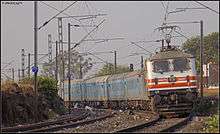New Delhi Habibganj Shatabdi Express
 | |||||
| Overview | |||||
|---|---|---|---|---|---|
| Service type | Shatabdi Express | ||||
| First service |
14 November 1988 between New Delhi & Jhansi, Uttar Pradesh | ||||
| Current operator(s) | Northern Railway | ||||
| Route | |||||
| Start | New Delhi | ||||
| Stops | 8 | ||||
| End | Habibganj | ||||
| Distance travelled | 707 km (439 mi) | ||||
| Average journey time | 8 hours 25 minutes as 12002 New Delhi Habibganj Shatabdi Express, 8 hours 30 minutes as 12001 Habibganj New Delhi Shatabdi Express | ||||
| Service frequency | daily | ||||
| Train number(s) | 12001 / 12002 | ||||
| On-board services | |||||
| Class(es) | Executive Chair Car, AC Chair Car | ||||
| Seating arrangements | Yes | ||||
| Sleeping arrangements | No | ||||
| Catering facilities | Yes | ||||
| Observation facilities | LHB large windows | ||||
| Baggage facilities | Yes | ||||
| Technical | |||||
| Track gauge | 1,676 mm (5 ft 6 in) | ||||
| Electrification | Yes | ||||
| Operating speed |
161 km/h (100 mph) maximum 100 km/h (62 mph), including halts | ||||
| |||||
The 12002 / 01 New Delhi Habibganj Shatabdi Express is a train operated by the Northern Railway which runs between New Delhi, the main railway station of India's capital territory, New Delhi, and Habibganj the second railway station of Bhopal City, the state capital of central Indian state of Madhya Pradesh. Next to Gatimaan Express, this is the second fastest train in India with the top speed of 150 km/h. Like Gatimaan Express this train is also a category of semi high speed train.
on the New Delhi-Agra stretch.[1] The train commenced service in 1988 and was the first Shatabdi train to be introduced. The train runs at an average speed of 100 km/h (62 mph), including halts. There is a plan by the IR to cut short its travel time of 2 hours 06 minutes to 1 hour 35 minutes (95 minutes) in the New Delhi -Agra section at an average speed of 125 km/h (78 mph) when the Maximum Permissible Speed in this section is enhanced to 200 km/h (124 mph). This train has been recently extended to Habibganj in the railway budget of 2014-15 .
History
The name "Shatabdi" means centenary in Sanskrit. The first Shatabdi Express train was introduced in 1988 to commemorate the birth centenary of Jawahar Lal Nehru, the first Prime Minister of India. Madhavrao Scindia was the Indian Railway Minister [2] at that point of time and the Shatabdi Express was his brainchild. The first Shatabdi Express was flagged off between New Delhi and Jhansi, which was later extended to Bhopal being extended to Habibganj.[3] It was planned to run this train between Gwalior(GWL) and New Delhi(NDLS), but Indian Railway wanted a good response for this train so they made it run between Jhansi and New Delhi.

Train
The trains are fully Air-conditioned and of a much higher standard than most Indian rail coaches. Shatabdi Express travelers are provided with snacks, meals, coffee/tea, a one-litre water bottle/ 300ml packaged water (for short distance journey) provided by the railways owned and operated subsidiary '"Rail Neer", and juice.
The train runs with new imported LHB coaches on all days. The cost of meals, breakfast etc. is all covered in the booking fare.
Loco link
It is regularly hauled by WAP 5 of Ghaziabad Shed.
Destinations
The train runs across the tourism hub of India covering major tourist cities like New Delhi, Agra Cantonment, Mathura Junction, Gwalior, Jhansi & Bhopal.
The complete list of stations is as follows:
- New Delhi
- Mathura Junction
- Agra Cantonment
- Dholpur Jn.
- Morena
- Gwalior
- Jhansi Junction
- Lalitpur Junction
- Bhopal Junction
- Habibganj
Coach Composition
The train has 17 AC Chair cars, 3 AC First class, 2 power cars (Total 22 coaches)
| Loco | 1 | 2 | 3 | 4 | 5 | 6 | 7 | 8 | 9 | 10 | 11 | 12 | 13 | 14 | 15 | 16 | 17 | 18 | 19 | 20 | 21 | 22 |
|---|---|---|---|---|---|---|---|---|---|---|---|---|---|---|---|---|---|---|---|---|---|---|
| EOG | E1 | E2 | E3 | C1 | C2 | C3 | C4 | C5 | C6 | C7 | C8 | C9 | C10 | C11 | C12 | C13 | C14 | C15 | C16 | C17 | Eg |
See also
- Fastest trains in India
- Bhopal Express
- Taj Express
- List of named passenger trains of India
- Indian Railways - Travel Coach types and their seating / berths
References
- ↑ "India's fastest train flagged off". rediff.com. 2006-02-15. Retrieved 2012-03-22.
- ↑ "[IRFCA] Railway Ministers". irfca.org.
- ↑ Chirdeep Bagga (2006-02-17). "Fastest train claim gone in 60 seconds". The Times of India. Retrieved 2012-03-22.
